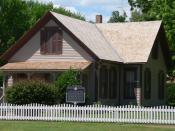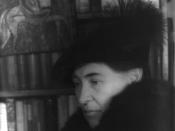Willa Cather's use of landscape
Willa Cather's style was polished, sincere and apparent. She had a technique that was more sophisticated than the great European tradition. The young Willa Cather - as she is revealed in her writing of the mid-nineties - was primarily a romantic and a primitive ("The Kingdom of Art" 31). Her creative vision was peculiarly profound, primitive, psychological and precise. It forced readers to use their senses to visualize scenes and be more involved. Cather's writing allowed for the back door of the reader's mind to remain open and to bring about people's instincts. She felt that conventional themes of love, despair, truth and beauty, were very important qualities. Cather wrote about life itself so passionately that the characters she created seemed to be more authentic than the characters of history. Her move to the Divide immensely influenced her writings, "she used the land as an instrument for the revelation of human character and purpose" ("The Plow and the Pen" 78).
Her distinctive ability of presenting people's fates, and the beauty of nature harmonically, made her name famous and her novels and short stories such as "On the Divide," "Lou the Prophet" and "A Wagner Matinee" leaving readers simply captivated by the environment's simplicity and primitivism. More than that, Cather's works express the penetrating global idea of intercultural dependency on environment intertwined with the universal story of the rise of civilizations in history.
In these short stories, the characters are all vastly diverse but every one has the reoccurring reminder of the unsympathetic land. "The Nebraska prairie also acts as a character in
these novels, interaction with all the human characters and influencing their lives in powerful and subtle ways. The land is often referred to as if it were a person"...
![[Portrait of Mary Lou Williams, Jack Teagarden, Dixie Bailey, Hank Jones, Tadd Dameron, and Milt Orent, Mary Lou Williams' apartment, New York, N.Y., ca. Aug. 1947] (LOC)](https://s.writework.com/uploads/9/91750/portrait-mary-lou-williams-jack-teagarden-dixie-bailey-hank-thumb.jpg)

